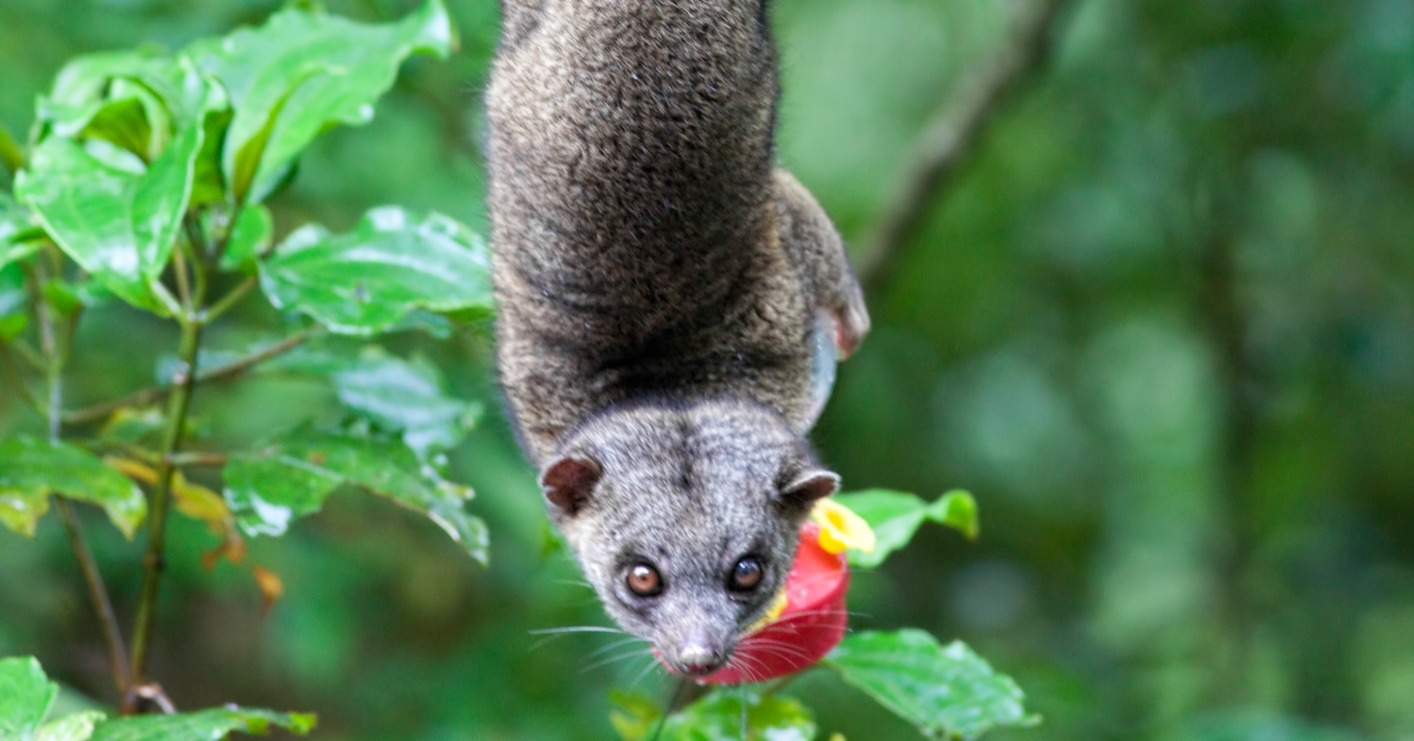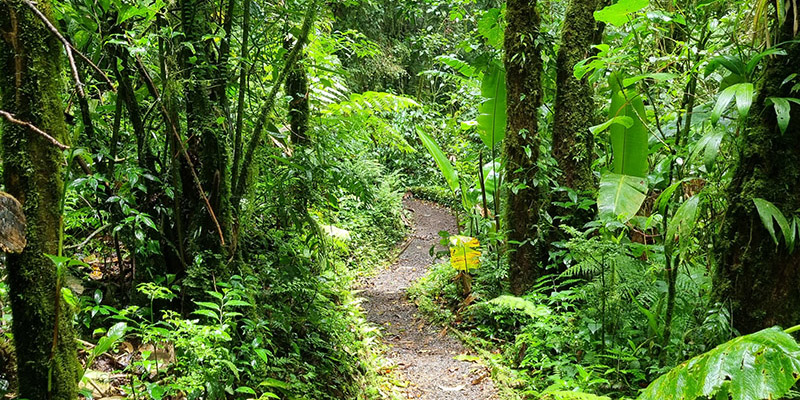Valle Escondido Reserve: From Night to Day

I was fortunate to spend some time at the Valle Escondido Nature Reserve recently. Unlike the Monteverde Cloud Forest and the others that I have mentioned in the past, Valle Escondido is a private reserve. It’s also a little lower in elevation, making it a transitional forest, instead of a cloud forest.
Some friends and I decided to visit the reserve, and to go through both at night, and during the day. It’s really interesting to both see, and hear, the differences between the two. We arrived around suppertime, not long before the tour was to start, and met our lovely guide named Liselle.
As she handed out our little flashlights, she explained that she had been a tour guide for 18 years, and that doing this in Costa Rica is a career, not a job. There are several levels of guide and each requires training. For her level, she had done the equivalent of two years in college in order to become certified.
She gave us a quick rundown of what not to do before we set out. Always stay together (since our flashlights were purposely not bright to avoid startling wildlife), don’t sit or lean on anything (good note!), and always let her lead so we don’t scare away the animals.
It seemed reasonable enough. We all agreed, tested our flashlights, and set out into the darkening forest. I have mentioned this in previous posts, but I will do so again because it was quite a surprise to me. Because Costa Rica is so close to the equator, the sun rises and sets at almost exactly the same time every day. Sunset is around 5:30, and by the time our tour started at 5:45, the sky was already dark.
It’s strange to me because at home in Canada, warm weather means a prolonged dusk and it’s often light(ish) well past 9 pm. Not so here. I took the picture you see above about twenty minutes before our tour, and the dark green you see at the bottom is actually the top of the forest canopy.
Nighttime in a Transitional Forest
A short distance along the trail, the land began to drop away and we descended down several flights of stairs. The trail was really well groomed, and while the stairs were packed dirt, they were level and edged with wooden boards to prevent erosion.
I’m always talking about the sounds of Costa Rica, and how different they are from those of home. Eventually, when I get enough sound bites, I plan to write a post about it. And I have to say it was eerie to step into the dark jungle, and to hear the sounds of civilization fade away behind us.
But the forest is never silent. The sounds that we’re familiar with were replaced with chirps and croaks, and a hum that would get quite loud one minute and then disappear for a few seconds before starting again. The sounds themselves are quite hard to describe, which is why I can’t wait to share the audio. The guide Liselle informed us that not one of the many noises happening around us was made by a bird, or an animal. Everything we were hearing was created by some form of insect, frog, or toad.
The sound of the jungle at night is the sound of bugs, and the creatures that eat them. Liselle also pointed out that the noise would stop when we approached, and like clockwork, it did. Weird to think that they were all so aware of us!
Creatures, regardless of what they are, change their habits when the sun goes down. During the day birds, animals, and snakes who think they have been spotted by a predator will run to escape. At night, they freeze. She said that we may see many animals and birds that are not necessarily active at night, but that their normal reaction to danger or being spotted is to stay still or change position and shape.
This is because at night, there are no colours. To “see” things, predators rely on the shapes. Specifically, they search for shapes that stand out from the natural landscape. Knowing this, animals who feel like they are in danger will rely on camouflage not of color, but of their profile and outline.
She found some thorn bugs and used them as an example to explain what she meant.
What you’re looking at isn’t a thorny plant, it’s a cluster of little bugs, known as thorn bugs! They have many predators and they use their shape, which resembles a thorn, to hide. At night they group together on the branch like this. It makes them look like a spiky section of the tree which other creatures tend to avoid.
During the day they’re a little more bold and will spread out along the branch, and the result is a branch that looks like it has evenly spaced thorns- like the stem of a rose. Still a great hiding place, but a little different to how they hide at night.
Birds and other animals which need to sleep during the night will also change their outer shape to more easily hide. For example, some types of bird will puff themselves up so they don’t resemble a bird anymore, and instead look like a big lumpy plant, or fruit.
Another example is spiders, who will curl up into a ball so they don’t look like a spider as a defense mechanism.
When we first ran into this little guy, he had just caught a bug and was busily wrapping him up in silk. When we stayed a bit too long and he started to worry, he pulled all his legs inwards to change the way he looked so we would go away. “Not something to eat!” he’s telling us. “Just a piece of leaf litter.”
I didn’t get very many pictures on the night tour because my camera needs the light to focus, but I did learn alot about the wildlife in the forest. We saw several spiders including an orange-kneed tarantula, a possum, lots of bugs, a scorpion (which will fluoresce under black light), ants, and the cicadas which made the loud humming noise.
Click the play icon below to hear what I mean:
We also saw an Olingo which is quite rare, and a special treat to spot in the wild. Liselle said the population, which was originally threatened, is making a comeback and that it has gone from being almost endangered to being protected instead. It looked a lot like a lemur.
Hiking
The next day we had a lovely breakfast with ingredients grown on-site and then laced up our hiking shoes and headed back into the forest. My friends are quite adventurous (and younger than I), so we decided to do a trail that runs all the way around the property. It was 2.5 km long and had quite a few lookout points.
While at night, we concentrated on identifying sounds and looking for shapes, the jungle in the daytime was all about the plants… and the view. It’s not that we didn’t want to see animals, but during the day they are a little more careful about hiding from predators that search by sight. So we had a little less of an advantage!
And there was just so much to see, I often kept forgetting to look for animals anyway! Under the trees, there is life everywhere. Vines hanging down or creating interesting “doorways” like in the picture. Plants that grow on other plants. Like the many varieties of orchid.
I spent so much time looking at the many plants and trees, concentrating on where to put my feet, and loudly panting my way up and down stairs, I didn’t mind that we didn’t see very many animals. Definitely need to get a little more used to hiking before I try to spot animals during the day!
But all that aside, the view when we made it to one of the lookout points was worth the effort.
The path we had chosen ran along a deep gorge with a creek at the bottom. Thanks to the mountainous terrain, there were several waterfalls along the path.
There were also beautiful vistas to gaze at while we rested.
And some truly gigantic ficus trees.
The forest is an awe-inspiring place, whether you view it by flashlight or wander its pathways in the light of the day.
So Many Places to Learn from Nature
There is much to be learned from an ecosystem that is so diverse, and has so much symbiosis going on.
Nothing in the forest exists alone. Each insect, bird, and tree has a part to play, and that part affects everything else. Just ask your guide when wandering through — like Liselle, they’ll probably light up, and have incredible stories to share about how every plant, fungus, and animal is interconnected and important.
If mankind can learn the lesson, what a fabulous world it could be!
I hope you get a chance to see the wonders of the woods for yourself, until then…
Pura Vida!





